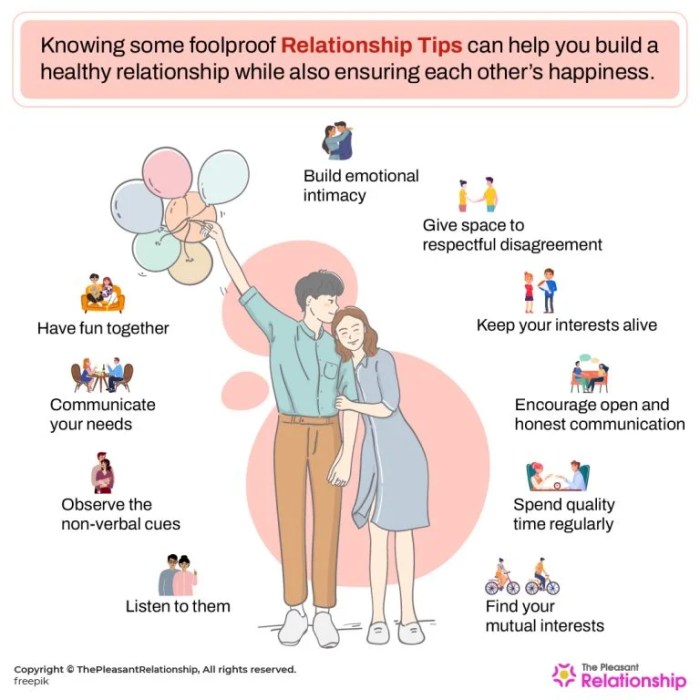Navigating the complexities of romantic relationships requires a nuanced understanding of communication, conflict resolution, and boundary setting. This guide delves into the specific dynamics of US relationships, exploring common communication styles, effective conflict resolution strategies, and the crucial role of healthy boundaries. We’ll examine assertive, passive, and aggressive communication, offering practical tools and techniques to foster stronger, more fulfilling partnerships.
From understanding nonverbal cues to developing a personalized communication plan, we'll equip you with the skills to navigate disagreements constructively and build a relationship built on mutual respect and understanding. We'll also address the unique challenges presented by cultural diversity within the US context, ensuring our advice resonates with a broad range of couples.
Communication Styles in US Relationships

Source: luvze.com
Common Communication Styles and Their Effectiveness
Several communication styles frequently appear in US relationships. Assertive communication, characterized by expressing needs and opinions respectfully while considering the other person's feelings, generally fosters healthy relationship dynamics. Passive communication, involving suppressing one's own needs to avoid conflict, often leads to resentment and unresolved issues. Conversely, aggressive communication, marked by hostility and disregard for the other person's feelings, can be highly damaging to a relationship. Effective communication involves a balance of assertiveness, empathy, and respect. For instance, a couple might assertively discuss their differing views on finances, actively listening to each other's perspectives and finding a compromise, rather than resorting to passive avoidance or aggressive accusations.Assertive, Passive, and Aggressive Communication Styles
Assertive communication involves clearly expressing one's needs and opinions while respecting the other person's perspective. This style promotes mutual understanding and problem-solving. Passive communication, in contrast, involves suppressing one's feelings and needs to avoid conflict. This can lead to bottled-up emotions and resentment. Aggressive communication is characterized by hostility, blaming, and a disregard for the other person's feelings, often resulting in damaged trust and conflict. The impact on relationship dynamics is significant; assertive communication strengthens the bond, while passive and aggressive styles erode it. A couple consistently using assertive communication is more likely to navigate disagreements constructively and maintain a healthy relationship.A Communication Plan for Improved Understanding and Empathy
A successful communication plan involves several key steps. First, establish dedicated time for open and honest communication, free from distractions. Second, actively listen to your partner, seeking to understand their perspective rather than formulating a response. Third, use "I" statements to express your feelings and needs without blaming your partner. For example, instead of saying "You always leave the dishes dirty," try "I feel frustrated when the dishes are left unwashed." Fourth, practice empathy by trying to see the situation from your partner's point of view. Finally, regularly check in with each other to assess the effectiveness of your communication and make adjustments as needed. Consistent effort and mutual commitment are vital for this plan's success.The Role of Nonverbal Communication
Nonverbal communication, including body language and tone of voice, plays a significant role in US relationships. A dismissive tone or crossed arms can convey negativity even if the words themselves are positive. Conversely, a warm smile and open posture can enhance positive interactions. Inconsistencies between verbal and nonverbal communication can lead to confusion and misunderstandings. For example, saying "I'm fine" while exhibiting slumped shoulders and a flat tone can indicate underlying dissatisfaction. Paying attention to both verbal and nonverbal cues is essential for accurate communication and building strong relationships.Comparison of Communication Styles
| Communication Style | Verbal Behavior | Nonverbal Behavior | Relationship Impact |
|---|---|---|---|
| Assertive | Expresses needs clearly and respectfully; uses "I" statements; actively listens | Maintains eye contact; open posture; calm tone of voice | Strengthens the relationship; promotes mutual understanding |
| Passive | Avoids expressing opinions or needs; agrees readily; avoids conflict | Avoids eye contact; slumped posture; quiet or hesitant tone | Leads to resentment; unresolved conflicts; weakens the relationship |
| Aggressive | Blames; uses accusatory language; interrupts; disregards others' feelings | Points fingers; clenched fists; loud or harsh tone | Damages trust; creates conflict; weakens the relationship |
Navigating Conflict in US Relationships
Conflict is an inevitable part of any relationship, including those in the United States. However, the way couples navigate disagreements significantly impacts the longevity and health of their partnership. Understanding effective conflict resolution strategies is crucial for building a strong and resilient relationship.Effective Conflict Resolution Strategies
Constructive conflict resolution involves addressing disagreements in a way that strengthens the relationship rather than damaging it. This requires a shift from focusing on winning or being right to finding mutually acceptable solutions. Key strategies include active listening, empathy, compromise, and a willingness to understand the other person's perspective. Avoiding personal attacks, name-calling, and bringing up past grievances are essential for maintaining a respectful dialogue. Focusing on the issue at hand, rather than escalating the conflict with unrelated matters, also contributes to a more productive resolution.Cultural Differences and Conflict Resolution
The United States is a diverse nation, and cultural backgrounds significantly influence how individuals approach conflict. For instance, some cultures prioritize direct communication, while others favor indirect approaches to avoid confrontation. Differences in communication styles can lead to misunderstandings and escalate conflicts if not acknowledged and addressed. Couples from different cultural backgrounds may need to consciously learn each other's communication styles and adapt their approaches to conflict resolution accordingly. Open communication about cultural differences and expectations is crucial for navigating disagreements effectively. Understanding the nuances of individual cultural backgrounds and how they impact communication can help prevent misunderstandings and foster more productive conversations.Common Conflict Triggers and De-escalation Methods
Several common triggers frequently ignite conflict in US relationships. Financial disagreements, household chores, parenting styles, and differing levels of intimacy are frequent sources of tension. De-escalation techniques involve recognizing when a conflict is escalating and taking steps to calm the situationActive Listening and Empathy in Conflict Resolution
Active listening and empathy are foundational to resolving disagreements constructively. Active listening involves fully concentrating on what the other person is saying, both verbally and nonverbally, without interrupting or formulating a response. Empathy involves attempting to understand the other person's perspective and feelings, even if you don't agree with them. By demonstrating active listening and empathy, couples create a safe space for open and honest communication, allowing them to address the root causes of the conflict. This fosters understanding and mutual respect, making it easier to find mutually agreeable solutions. Practicing active listening and empathy strengthens the emotional connection between partners, which is crucial for navigating disagreements peacefully.A Step-by-Step Guide to Peaceful Conflict Resolution
A structured approach can significantly improve the outcome of conflict resolution. First, identify the specific issue causing the conflict. Next, each partner should express their feelings and perspectives without interruption. Then, actively listen to each other, seeking to understand the other's viewpoint. After understanding each other's perspectives, collaboratively brainstorm potential solutions. Finally, agree on a solution that addresses both partners' needs and concerns. Regularly reviewing and adjusting the agreed-upon solution, if needed, helps maintain a positive and productive approach to conflict resolution. This structured process helps to prevent emotional escalation and promotes a more collaborative and constructive approach to resolving disagreements.Maintaining Healthy Boundaries in US Relationships

Source: thepleasantrelationship.com
The Significance of Healthy Boundaries
Healthy boundaries in romantic relationships define the limits of acceptable behavior and interaction between partners. They protect each individual's physical, emotional, and mental well-being, ensuring that both partners feel respected and valued. These boundaries are not about creating distance or preventing intimacy; rather, they are about creating a space where both partners can thrive individually while nurturing a strong connection. A relationship built on mutual respect for boundaries fosters a healthier, more sustainable dynamic.Examples of Healthy and Unhealthy Boundaries
Healthy boundaries manifest in various ways. For instance, a healthy boundary might involve having separate time for personal hobbies and interests, maintaining independent friendships, or having open communication about financial matters and individual spending habits. Conversely, unhealthy boundaries might include neglecting personal needs to constantly please a partner, allowing a partner to control your finances, or tolerating disrespectful or abusive behavior in the name of "commitment." Another example of an unhealthy boundary is consistently prioritizing a partner's needs above your own, leading to feelings of resentment and burnout. Healthy boundaries, on the other hand, allow for both partners to maintain their individuality while fostering a supportive and loving partnership.Challenges in Setting and Respecting Boundaries
Setting and respecting boundaries often presents challenges for couples. Fear of conflict or rejection can prevent individuals from expressing their needs and limits. Past experiences, such as growing up in families with unclear boundaries, can also make it difficult to establish healthy boundaries in adult relationships. Additionally, differing cultural backgrounds or communication styles can contribute to misunderstandings and difficulties in navigating boundary setting. A lack of self-awareness and assertiveness can also impede the process. Overcoming these challenges requires open communication, empathy, and a willingness to compromise.Effective Communication and Boundary Setting
Effective communication is paramount in establishing and maintaining healthy boundaries. This involves clearly articulating one's needs and limits using "I" statements, actively listening to one's partner's perspective, and engaging in respectful dialogue. It's crucial to avoid blaming or accusatory language, focusing instead on expressing personal feelings and experiences. Compromise and negotiation are essential components of effective boundary communication, ensuring that both partners feel heard and respected. Regular check-ins and open discussions about boundary needs are vital for maintaining a healthy relationship dynamic.Practical Tips for Establishing and Maintaining Healthy Boundaries
Setting and maintaining healthy boundaries requires conscious effort and consistent practice. Here are some practical tips:- Clearly communicate your needs and limits to your partner using "I" statements. For example, instead of saying "You always interrupt me," try "I feel unheard when I'm interrupted. Could we work on improving our listening skills?"
- Respect your partner's boundaries, even if they differ from your own. Recognize that your partner has a right to their own needs and preferences.
- Establish individual time for personal pursuits and self-care. This allows for personal growth and prevents feelings of being overwhelmed or losing oneself in the relationship.
- Maintain separate friendships and social connections. Having independent social lives strengthens individual identities and reduces reliance on the romantic partner for all social needs.
- Learn to say "no" assertively and respectfully when you feel uncomfortable or overwhelmed. This is a crucial skill for protecting personal boundaries.
- Seek professional help if you are struggling to establish or maintain healthy boundaries. A therapist can provide guidance and support in navigating these challenges.